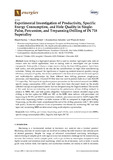JavaScript is disabled for your browser. Some features of this site may not work without it.
| dc.contributor.author | Sarfraz, Shoaib | |
| dc.contributor.author | Shehab, Essam | |
| dc.contributor.author | Salonitis, Konstantinos | |
| dc.contributor.author | Suder, Wojciech | |
| dc.date.accessioned | 2019-12-05T15:26:23Z | |
| dc.date.available | 2019-12-05T15:26:23Z | |
| dc.date.issued | 2019-12-04 | |
| dc.identifier.citation | Sarfraz S, Shehab E, Salonitis K, Suder W. Experimental investigation of productivity, specific energy consumption, and hole quality in single-pulse, percussion, and trepanning drilling of IN 718 superalloy. Energies, Volume 12, Issue 24, December 2019, Article number 4610 | en_UK |
| dc.identifier.issn | 1996-1073 | |
| dc.identifier.uri | https://doi.org/10.3390/en12244610 | |
| dc.identifier.uri | https://dspace.lib.cranfield.ac.uk/handle/1826/14801 | |
| dc.description.abstract | Laser drilling is a high-speed process that is used to produce high aspect ratio holes of various sizes for critical applications, such as cooling holes in aero-engine and gas turbine components. Hole quality is always a major concern during the laser drilling process. Apart from hole quality, cost and productivity are also the key considerations for high-value manufacturing industries. Taking into account the significance of improving material removal quantity, energy efficiency, and product quality, this study is performed in the form of an experimental investigation and multi-objective optimisation for three different laser drilling processes (single-pulse, percussion, and trepanning). A Quasi-CW fibre laser was used to produce holes in a 1 mm thick IN 718 superalloy. The impacts of significant process parameters on the material removal rate (MRR), specific energy consumption (SEC), and hole taper have been discussed based on the results collected through an experimental matrix that was designed using the Taguchi method. The novelty of this work focuses on evaluating and comparing the performance of laser drilling methods in relation to MRR, SEC, and hole quality altogether. Comparative analysis revealed single-pulse drilling as the best option for MRR and SEC as the MRR value reduces with percussion and trepanning by 99.70% and 99.87% respectively; similarly, percussion resulted in 14.20% higher SEC value while trepanning yielded a six-folds increase in SEC as compared to single-pulse drilling. Trepanning, on the other hand, outperformed the rest of the drilling processes with 71.96% better hole quality. Moreover, optimum values of parameters simultaneously minimising SEC and hole taper and maximising MRR are determined using multi-objective optimisation. | en_UK |
| dc.language.iso | en | en_UK |
| dc.publisher | MDPI | en_UK |
| dc.rights | Attribution 4.0 International | * |
| dc.rights.uri | http://creativecommons.org/licenses/by/4.0/ | * |
| dc.subject | laser drilling | en_UK |
| dc.subject | percussion | en_UK |
| dc.subject | trepanning | en_UK |
| dc.subject | productivity | en_UK |
| dc.subject | cost | en_UK |
| dc.subject | material removal rate (MRR) | en_UK |
| dc.subject | specific energy consumption (SEC) | en_UK |
| dc.subject | Taguchi | en_UK |
| dc.subject | hole taper | en_UK |
| dc.subject | IN 718 | en_UK |
| dc.title | Experimental investigation of productivity, specific energy consumption, and hole quality in single-pulse, percussion, and trepanning drilling of IN 718 superalloy | en_UK |
| dc.type | Article | en_UK |
Files in this item
The following license files are associated with this item:
This item appears in the following Collection(s)
-
Staff publications (SATM) [4362]

